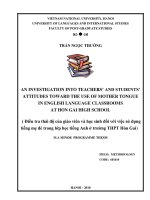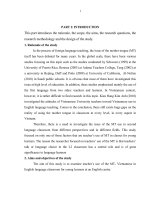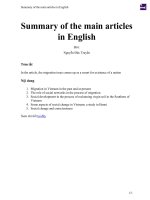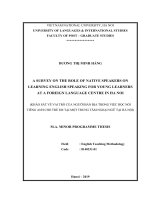SUMMARY OF THESIS TEACHERS USE OF THE MOTHER TONGUE IN ENGLISH LANGUAGE CLASSROOMS FOR YOUNG LEARNERS AT A LANGUAGE CENTER A CASE STUDY
Bạn đang xem bản rút gọn của tài liệu. Xem và tải ngay bản đầy đủ của tài liệu tại đây (132.4 KB, 15 trang )
1
PART I: INTRODUCTION
This part introduces the rationale, the scope, the aims, the research questions, the
research methodology and the design of the study.
1. Rationale of the study
In the process of foreign language teaching, the issue of the mother tongue (MT)
itself has been debated for many years. In the global scale, there have been various
studies focusing on this topic such as the studies conducted by Schweers (1999) at the
University of Puerto Rico, Beressa (2003) at Adama Teachers College, Tang (2002) at
a university in Beijing, Duff and Polio (2009) at University of California, Al-Nofaie
(2010) in Saudi public schools. It is obvious that most of them have investigated this
issue at high level of education. In addition, these studies emphasized mainly the use of
the first language from two sides: teachers and learners. In Vietnamese context,
however, it is rather difficult to find research in this topic. Kieu Hang Kim Anh (2010)
investigated the attitudes of Vietnamese University teachers toward Vietnamese use in
English language teaching. Comes to the conclusion, there still exists huge gaps on the
reality of using the mother tongue in classroom at every level, in every aspect in
Vietnam.
Therefore, there is a need to investigate the issue of the MT use in second
language classroom from different perspectives and in different fields. This study
focused on only one of those factors that are teacher’s use of MT in classes for young
learners. The reason the researcher focused on teachers’ use of the MT is that teachers’
talk or language choice in the L2 classroom has a central role and is of great
significance to language learners
2. Aims and objectives of the study
The aim of this study is to examine teacher’s use of the MT- Vietnamese in
English language classroom for young learners at an English centre.
2
The objectives of the study are investigating the amount of L1 use by teachers
of different levels and the reasons underlying their L1 using. In addition, teachers’
belief about L1 use is also addressed in order to find out the concordance to their
practices.
In order to achieve the aim, the study addresses these following main questions:
1. How much L1 is used and in which sections do teachers use L1 in the
classroom?
2. Why do teachers use the mother tongue?
3. What are teachers’ beliefs about MT use? Do teacher’s beliefs correlate to their
practices?
3. Scope of the study
In practice, L1 can be used by both students and teachers in L2 classroom. However,
within the framework of this minor thesis, the study only focuses on teachers’ use of
the MT in English classes for young learners. Specifically, the study aims at
investigating the amount of L1 use by teachers of different levels and the reasons
underlying their L1 using. In addition, teachers’ belief about L1 use is also addressed
in order to find out the concordance to their practices.
4. Methods of the study
The study is carried out in form of a qualitative multi case study approach in
which three teachers teaching three different levels for young learners will be
investigated in order to compare and contrast their MT use in L2 classroom. Three
research methods, including classroom observation, stimulated recall interview, and
semi- structured interview are used to reach the aim of the study. The researcher
believes that the combination of different methods to collect data could provide more
reliable and valid information for analysis. Classroom observations are used to
discover the amount and in which sections Vietnamese was used. Stimulated recall
interview was applied to gain insights into teachers’ rationale of using the MT in the
3
classroom. The recall interviews were fully transcribed and analyzed qualitatively
according to emerging themes. The semi-structured interviews are to explore teachers’
opinions of the use of the first language in the classroom, and then compared with
teacher’s practices. Semi structured interviews were conducted after finishing all
observations and stimulated interviews. As in the case of stimulated recall, semi
structured interviews were transcribed fully.
5. Layout of the thesis
This thesis consists of three parts, namely Introduction, Development and
Conclusion.
Part I, the Introduction, presents the rationale, the aims, the scope, the method and the
design of the study.
Part II, the development, consists of three chapters. Chapter 1, the Literature review,
Chapter 2, the Methodology, introduces the participants, the data collection instruments
and data analysis procedure. Chapter 3 (Results and Discussions) mainly deals with the
results and the discussion of the findings.
Part III is the Conclusion of the study. In this part, the major findings, some
recommendations, limitations of the research as well as suggestions for further study
are presented.
The appendixes are the last part of the study following the reference.
4
PART II: DEVELOPMENT
CHAPTER 1: LITERATURE REVIEW
This chapter provides background information on the use of L1 in the L2
classroom. Firstly, it presents definitions of young learners. Secondly, it discusses the
role of L1 in major ELT methodologies. Thirdly, it gives an insight into theoretical and
practical research favoring or not favoring the use of L1. Fourthly, it deals with the use
and amount of L1 use in the English class. It also discusses some empirical researches
on the L1 use in L2 classroom.
1.1. Young learners
1.2. History of the use of L1 in L2 classroom
1.3. Debating surrounding the use of L1 in the L2 classroom
1.3.1. Arguments against L1 use
1.3.2. Arguments favoring L1 use
1.4. Use of L1 in L2 classroom
1.5. The amount of L1 in the English classroom
1.6. Empirical researches
5
CHAPTER 2: METHODOLOGY
2.1. Qualitative Multi case study approach
In the present study, a qualitative multiple case study approach was employed
due to the following reasons:
To begin with, a multiple case study was conducted because it helps understand
the case in depth and detailed description of specific phenomenon. According to
Cohen, Manion, & Morrison (2007), case studies are useful for analytic rather than
statistical generalization It enables the researcher to answer “how” and “why” type
questions, while taking into consideration how a phenomenon is influenced by the
context within which it is situated.
Secondly, collective case study enables the researcher to analyze within each
setting and across setting. In a multiple case study, some cases are being examined to
understand the similarities and differences between the cases (Baxter and Jack, 2008:
550).
In general, qualitative multi-case study research was considered to be the most
appropriate approach for the present study. It was believe that the study could
contribute somehow for further investigation in teacher’s use of L1 in L2 classroom.
2.2. Setting and Participants
2.2.1. Setting
The study was conducted in an English Centre. The centre addresses children with age
range from three to twelve years old. Students are divided into classes due to their age
and sometimes their level. In this English centre, Vietnamese is the only mother tongue
and English as the foreign language.
2.2.2. Participants
Three teachers of English, who are teaching three different levels at this English
Center, then were invited to share their opinion and experience on the investigated
issue.
6
Although they can come from diverse education background, all three teachers
already passed the training courses in teaching English for kids, the condition to work
in the English School, which hold by the headquarter. In addition, teachers also attend
annual workshop which invite experts in teaching kids to train new skills. Like
students, all of them are native speakers of Vietnamese.
2.3. Data collection Instruments
The techniques employed in this study were non- participant classroom
observation, stimulated recall technique and semi- structured interviews. The
combination of these three instruments was used to achieve a triangulation of data and
thus generate the validity and reliability of the study.
2.3.1. Classroom observation
In the study, a structured observation format, which was modified from Cook
(2001), Atkinson (1987), and Cameron (2001), was used. What was observed during
the class was the amount of the MT and the TL used by teachers in different lesson
sections. The researcher observed three different level English classes (each class will
be observed four times). The researcher played as non- participant observation.
2.3.2. Stimulated Recall (Appendix 2)
In this study, SR was conducted during 24 hour after the observed lesson in
order to make sure that the information was fresh and the research would get the best
information. Because of the limited time, the researcher could not interview teacher in
all four observed lessons, just two of them will be chosen to implement an interview.
Since the researcher was afraid that teachers’ proficiency under study was not good
enough to express all of their thinking, so the interview was conducted in Vietnamese.
Another reason for applying Vietnamese in interview is that both participants and the
researcher are Vietnamese, so it is easily to exchange idea and to dig deeply the
information. The researcher audio taped each SR interview and then transcribed.
2.3.3. Semi structured Interview (See Appendix 3)
7
A semi-structured interview was conducted with three teachers after finishing
all observations and stimulated interviews. As teachers’ responses might vary in the
topic questioned, a list of prepared questions was used as a guide. Therefore, some
changes could be applied due to the interviewees’ answers. Semi structured interview
also was conducted in Vietnamese and then interpreted in English. The questions were
asked in a fixed order and the interviews were audio recorded for transcription later.
2.4. Data collection procedure
Data collection started by contacting the principal of the private language center
informing her about the purpose of the study and asking for her consent for the
research to take place. Secondly, the teachers were contacted in person asking for their
consent to observe the classes and being involved in the SR and semi- structured
interview procedure.
The research started with classroom observations. Each teacher was observed
four times in a 60 minutes lesson of the different levels. Two of the observed lessons
were chosen in advance for stimulated recall interview. SR interviews were conducted
within 24 hours after the observation. After finishing all observations and SR, semi
structure interview was conducted to find out teachers’ belief about the L1 use in the
classroom.
2.5. Data analysis
This research applied qualitative and quantitative data analysis techniques.
Firstly, from the data in the observation sheet, the quantity of Vietnamese language and
English utterance during four observed lessons were calculated. The L1 use in different
sections were sorted out, summarized and analyzed qualitatively. Secondly, the data
from the stimulated interview was analyzed according to the emerging theme in the
interview. Finally, after finishing semi-structured interview, the researcher summarized
each teacher’s ideas, and then compared with the data obtained from the observation.
8
CHAPTER 3: FINDINGS AND DISCUSSION
This chapter will include the results obtained from data collected by the use of
classroom observation, SR interview and semi structure interview. The above results
then will be also analyzed and discussed according to the literature and other empirical
researches mentioned in chapter 1.
3.1. Findings
3.1.1. Case 1 (teacher in class for 5-6 years old students)
3.1.2. Case 2- teacher in class for 6- 8 years old students
3.1.2. Case 3- teacher in class for above 8 years old students
3.2. Discussion
The results of this study on teacher’s use of Vietnamese in English classroom
for young learners bear many similarities, differences to previous studies.
9
PART III: CONCLUSION
This concluding chapter provides the summary and evaluation of the whole paper by
giving summary of main findings, stating the recommendations, limitations of the
study as well as providing several suggestions for further investigation on L1 use in
English class for young children.
1. Summary of main findings
Based on the data obtained through the three instruments the following findings
could be presented:
Results revealed that the TL is the main medium of instruction in the classroom,
while Vietnamese was used occasionally when teachers found L2 failed to work. It also
indicated that the use of Vietnamese was an unavoidable phenomenon in English
classrooms for young learners.
Concerning the use of the MT in various sections, results showed significant
differences among different levels. Giving instruction, was the area that scored the
highest in MT use in classes for 5-6 years old while presenting/ explaining grammar
and vocabulary was the section applying MT in classes for 6-8 and above 8 years old.
Teachers had various reasons for employing Vietnamese. The common reason
that all teachers gave was the support of students’ understanding and learners’ level.
Beside this agreement, each teacher responded differently for her L1 employing. The
first case (teachers for 5-6 years old) cited three more reasons for her applying L1.
Unlike teacher1’s reasons, teacher 2 proposed that using Vietnamese in the class
facilitated the learning process. The notion of L1 serving as "a time–saving device" is
one justification for L1 use given by teacher 3.
Next, teachers have positive attitudes towards to the use of Vietnamese in
English language classroom. However, two out of three teachers do not plan when they
are going to use English or Vietnamese in the lesson. By drawing a connection between
10
teachers’ beliefs and their actions, it is observed that there is a general match between
teachers’ thought and their performance.
Researcher’s position as a result of this study is that ‘the MT taboo has been
with us for a long time, but fortunately now things seem to be changing. I believe that
many teachers have continued to use the MT because it is both necessary and
effective’ (Deller and Rincoluci, 2002:3). Teachers, then, can benefit from exploring
their own views on this issue and becoming aware of their reasons for using (or
avoiding) the L1 in their English lessons.
2. Recommendations
Based on the findings of the present study, the following recommendations are
offered.
The amount of L1 use and how it is employed should vary with classroom
environment.
Maximizing L2 use should be the goal in every classroom (Meyer, 2008).
However, teachers also have to find ways to modify their English input. It also is
recommendable that maximum L2 can be achieved through habit formation and
training.
Planning the language is going to be used in particular lesson sections could
help teachers be more consistent with the use of each language.
It is also recommended that the Ministry of Education should hold workshops,
programs and seminars on the role of the native languages in the EFL classroom.
3. Limitations
The study was conducted in one small language center with restricted sample
size. Therefore, generalization of the findings should be cautioned. Another limitation
is that although the teachers in this study were observed and interviewed, the number
of observations was still limited and the interviews did not yield sufficient in-depth
information because the researcher was lack of interview skill and experience.
11
4. Suggestions for further research
It is firstly suggested that in order to attain more convincing findings than the
ones collected in this paper, there are several areas which need improving. Most
obviously, the limitations of this research will be overcome with the increased number
of participants, which will make it more possible to generalize findings. Further studies
should be carried out to focus on the relation between teachers’ proficiency, teaching
experience, teachers’ gender with their L1 use. In addition, other studies could also
look at the relationship between teachers’ practices in using the L1 and learners’
proficiency or an analysis of learners’ perspectives on teachers’ L1 use would also
further develop the understandings of the issues. Another way to reach this issue is
conducting researches of the student’s use of L1 in the classroom. Overall, there are
many ways in which this research could be expanded in order to attain deep
information of the issue.
12
REFERENCES
Al-Alawi, T. M. (2008). Teachers’ beliefs and practices about the use of L1. In S. Borg
(Ed.). Investigating English language teaching and learning in Oman. Muscat:
Ministry of Education, Oman.
Al-Buraiki, M.A. (2008). The L1 in Young Learner Classrooms: Teachers' Views and
Practices. Retrieved September, 12, 2012 from
www.moe.gov.om/Portal/sitebuilder/sites/EPS/English/MOE/ /Ch2.pdf
Al-Nofaie, H. (2010). The attitudes of teachers and students towards using Arabic in
EFL classrooms in Saudi public schools- A case study. Novitas Royal Research
on Youth and Language, 4 (1), 64-95.
Atkinson, D. (1987). The mother tongue in the classroom: a neglected resource? ELT
Journal, 41/4, 241-247.
Atkinson, D. (1993). Teaching monolingual Classes. London: Longman.
Auerbach, E. R. (1993). Reexamining English only in the ESL classroom. RESOL
Quarterly, 27 (1), 1-18.
Available at />Baxter, P., & Jack, S. (2008). Qualitative case study methodology: study design and
implementation for novice researchers. The Qualitative Report, 13/4, 544-559.
Brewster et al. (2002). The primary English teacher’s guide. Harlow: Pearson
Education Limited.
Brown, H. D. (2000). Principles of language learning and teaching: Fourth edition.
New York: Pearson Education Company.
Cameron, L. (2001). Teaching languages to young learners. Cambridge: Cambridge
University Press.
Cohen, L., Manion, L., & Morrison, K. (2007). Research methods in education: Sixth
edition. New York: Routledge.
Cole, S. (1998). The use of L1 in communicative classroom. The language teacher
13
JALT Journal. Online internet.
Cook, V. (2001). Using the First Language in the Classroom. Retrieved February 24,
2012, from />Deller, S. & Rinvolucri, M. (2002). Using the Mother Tongue. Making the Most of the
Learner's Language. London: First pearson Publishing.
Do, T. K. V. (2010). A research into the role and the use of first language in General
English classes at Hanoi University of Industry. Unpublished Master of art,
Vietnam National University Hanoi, University of Languages and International
Studies, Hanoi.
Drosatou, V. (2009). The use of the mother tongue in English language classes for
young learners in Greece. Unpublished Master of Arts in ELT dissertation,
University of Essex.
Duff, P. A. (2008). Case study research in applied linguitics. New York: Lawrence
Erlbaum Associates.
Duff, P. A., & Polio, C. G. (1990). How much foreign language is there in the foreign
language classroom? The Modern Language Journal, 74 (2), 154-166.
Fox-Turnbull, W. (2009). Stimulated recall using autophotography: A method for
investigating technology education. In A. Bekker, I. Mottier, & M. J. de Vries
(Eds.) Proceedings of the 22
nd
Int. Technology & Engineering Educator's
Association Conference. (pp. 204 - 217). Retrieved May, 26 2012 from
/>Gabrielatos, C. (2001). L1 Use in ELT: not a skeletone, but a bone of contention: A
response to Prodromou. TESOL Greece Newsletter, 70, 6-9.
Harbord, J. (1992). The Use of the Mother Tongue in the Classroom. ELT Journal, 46,
350-355.
Kang, D. (2008). The classroom Language use of a Korean Elementary School: EFL
teacher: another look at TETE. System 36, 214- 226. Science Direct.
14
Kieu, H.K.A. (2010). Use of Vietnamese in English language teaching in Vietnam:
Attitudes of Vietnamese university teachers. English Language Teaching, 3/2,
119-128.
Krashen, S. D. (1981). Second Language Acquisition and Second Language Learning.
Oxford: Pergamon Press Inc.
Larsen-Freeman, D. (2000). Techniques and principles in language teaching. Oxford:
Oxford University Press.
Linse, C. T. (2005). Practical English language teaching: young learners. New York:
McGraw- Hill Comapanies, Inc.
Macaro, E. (2001). Analysing Student Teachers’ Codeswitching in Foreign Language
Classrooms: Theories and Decision Making. The Modern Language Journal
85 (4), 531-548.
Medgyes, P. (2001). ‘When the teacher is a non-native speaker’ in M.Celce-
Murcia(ed.). Teaching English as a Second or Foreign Language. Boston, MA:
Heinle & Heinle.
Meyer, H. (2008). The Pedagogical Implications of L1 Use in the L2 Classroom.
Retrieved September 12, 2012 from
Nation, P. (2003). The Role of the First Language in Foreign Language Learning. The
Asian EFL Journal, 5(2), 1-8. Retrieved September, 5, 2012 from:
/>Asian- EFL.pdf.
Pachler, N & Field, K. (2001). Learning to Teach Modern Foreign Languages in the
Secondary School. Routledge: London.
Paltridgle, B. & Phakiti, A. (2010). Continuum Companion to Research Methods in
Applied Linguistics. London/ New York: Continuum International Publishing
Group.
15
Patel, M. F., & Jain, P. M. (2008). English language teaching: methods, tools, &
techniques. Jaiput: Sunrise Publishers & Distributors.
Phillip, S. (1993). Young learners. Oxford: Oxford University Press.
Phillipson, R. (1992). Linguistics imperialism. Oxford: Oxford University press.
Prodromou, L. (2000). From Mother Tongue to Other Tongue. TESOL Quarterly, 67,
7-12 Retrieved July 5, 2010 from:
www.teachingenglish.org.uk/think/methodology/mother_tongue.shtml.
Richard, J. C., & Schmidt, R. (2010). Longman dictionary of language teaching and
applied linguistics: fourth edition. Harlow: Pearson Education Limited.
Richards, J. C., & Rodgers, T. S. (1986). Approaches and methods in language
teaching: a description and analysis. Cambridge: Cambridge University Press.
Schweers, C. W. (1999). Using L1 in the L2 classroom. English Teaching Forum, 37/2,
6-9.
Scott, W. A., & Ytreberg, L. H. (2004). Teaching English to children. London:
Longman.
Song, Y. (2009). An Investigation into L2 Teacher Beliefs about L1 in China. TESOL,
24(1), 30-39.
Tang, J. (2002). Using L1 in the English classroom. English Teaching Forum, 40/1.
Tran, N. T. (2010). An investigation into teachers' and students' attitudes toward the
use of mother tongue in English language classrooms at Hon Gai high school.
Unpublished M.A thesis, Vietnam National University Hanoi, University of
Languages and International Studies, Hanoi.
Weschler, R. (1997). Uses of Japanese (L1) in the English Classroom: Introducing the
Functional Translation Method. The Internet TESL Journal, 3(1), 1-12.
Retrieved July 25, 2012 from />Internet website









